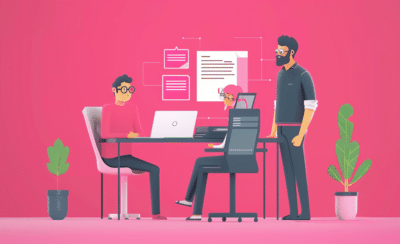User Experience (UX) and User Interface (UI) design are critical factors in the success of any B2B app. A well-designed app not only meets the needs of its users but also aligns seamlessly with the goals of the business. In this guide, we’ll explore ten essential best practices that should be at the forefront of your B2B app development process. By implementing these practices, you’ll not only enhance user satisfaction but also pave the way for a more profitable and impactful application.
TLDR; Contents
Prioritize Business Needs
Before diving into design, it’s imperative to understand the core objectives of your B2B venture. This means identifying the specific problems your app will address and shaping the design around those solutions. Consider how each design element contributes to the overarching business goals. For example, if streamlining communication is a primary objective, ensure that messaging features are prominent and intuitive.
Identify Target Audience and User Personas
To create a truly effective B2B app, you must first know who your users are. Develop detailed user personas that encompass the characteristics, pain points, and goals of your target audience. This information will serve as a compass, guiding design decisions towards a user-centric approach. For instance, if your app caters to both sales teams and project managers, tailor the interface to cater to the unique needs of each group.
Conduct Comprehensive User Research
User research is the cornerstone of user-centered design. Through surveys, interviews, and analytics, gather insights into user behavior, preferences, and pain points. This data will shape the design choices, ensuring that every element addresses a genuine user need. For example, if analytics reveal that users struggle with onboarding, consider implementing a guided tutorial or interactive walkthrough.
Maintain Consistency in Design Elements
Consistency is key to a seamless user experience. From color schemes and fonts to button styles and iconography, maintain uniformity throughout the app. Consistent branding instills trust and familiarity in users, making for a more intuitive and comfortable navigation experience. For instance, if your brand emphasizes a minimalist aesthetic, ensure that this principle extends consistently across all elements of the app.
Focus on Intuitive Navigation
Navigating a B2B app should be a straightforward and intuitive experience. Prioritize clear information architecture, ensuring that users can easily find what they’re looking for. Consider implementing hierarchical menus, breadcrumb trails, and intuitive search functionalities. By reducing cognitive load and streamlining navigation, users can efficiently accomplish their tasks within the app.
Prioritize Accessibility and Inclusivity
Inclusivity should be a cornerstone of B2B app design. Ensure that your app is accessible to all users, including those with disabilities. Provide alternative text for images, implement screen reader compatibility, and ensure color contrasts meet accessibility standards. By prioritizing inclusivity, you not only expand your user base but also contribute to a more equitable digital landscape. Psst, get your free accessibility checklist here by Goji Labs! Make your own copy and to check if your product is following the newest guidelines.
Optimize for Performance and Speed
In the fast-paced world of business, time is a precious commodity. Your B2B app must perform seamlessly and load swiftly. Compress images, minimize server requests, and leverage caching mechanisms. Additionally, conduct thorough performance testing to identify and address any bottlenecks. A snappy app not only enhances user satisfaction but also fosters increased productivity among your clients.
Implement Clear CTAs
Every screen in your B2B app should guide users towards their intended actions. Use clear, concise language for buttons and calls-to-action (CTAs). Make sure they are strategically placed, leveraging color and design elements to draw attention. For instance, if your goal is to encourage trial sign-ups, ensure the “Start Free Trial” button is prominently displayed and easily accessible.
Leverage Responsive Design
In today’s mobile-first world, it is essential to create an app with a responsive design so that it looks great on all devices, regardless of size or resolution. Responsive design is an approach to design and development that aims to ensure a website’s optimal viewing and functionality across a wide range of devices and screen sizes. In essence, responsive design allows websites to adapt and respond to the user’s device, providing a seamless and user-friendly experience whether they are accessing the site on a desktop computer, laptop, tablet, or smartphone.
Stay Up-To-Date with Industry Trends
The world of UX/UI design is dynamic, with new trends and technologies emerging regularly. Stay informed about industry developments, attending conferences, webinars, and workshops. Engaging with design communities and reading influential blogs can provide valuable insights. By keeping your finger on the pulse of industry trends, you’ll be well-equipped to implement the latest innovations into your B2B app.
In the realm of B2B app development, user experience and user interface design are non-negotiable factors for success. Prioritizing business needs, understanding your audience, conducting thorough research, and maintaining consistency are foundational steps. Additionally, accessibility, performance optimization, and clear CTAs are crucial for sustained success. By incorporating these ten best practices into your design process, you’re not only creating a user-friendly app but also setting the stage for a thriving B2B venture. Remember, the journey of UX/UI design is ongoing, and continuous improvement is the key to staying ahead in the competitive landscape of B2B applications.
Looking to build a custom product? Contact Goji Labs.




